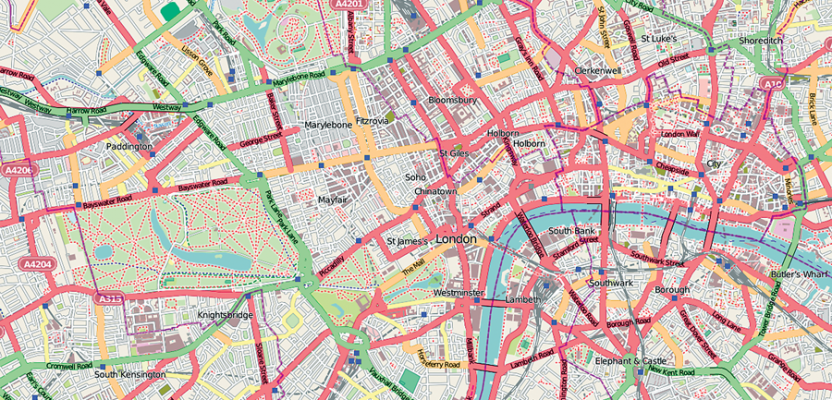“I’ve heard people say that cartography is dead. Where might that kind of thinking be coming from?” I asked Dr. Monmonier, distinguished author and professor of geography at Syracuse University. His response was, “Why would anyone in his or her right mind think cartography is, or might be, dead?”
This initiated a discussion about people mistakenly viewing the advent of the digital geodata age as somehow demoting cartography and mapping. We both agreed that the opposite is true: cartography has only benefitted from the digital geodata age; in fact, a renaissance of sorts has been underway for some time.
Mark Monmonier is editor of Cartography in the Twentieth Century, which will be released in the spring of 2015 as volume six of the History of Cartography. He has followed the evolution of cartography and mapping from both a scholarly and practical vantage point and is a celebrated expert and commentator on the subject. Monmonier has written dozens of books, including Lake Effect; No Dig, No Fly, No Go; How to Spy with Maps; Rhumb Lines and Map Wars; and the very popular How to Lie With Maps, which opens with an accessible treatise on projections. It was reflection on his 1985 Technological Transition in Cartography that prompted me to seek him for an update. It was written at the cusp of the digital geodata explosion, when many people had never even heard the term “GIS.”
Monmonier offers historical context. “In the 19th century the term ‘cartography’ referred to the systematic, scholarly study of old maps and mapping methods. In the 20th century it came to mean more specifically map making,” he said. “It has been presented in the works of Arthur Robinson [who wrote the influential Elements of Cartography] and Erwin Raisz [author of General Cartography].”
Monmonier explained that maps are created to convey available data with certain fundamentals of style, with fidelity, and with as much relevance as possible. And, as he has noted in his many publications, the amount of data available has grown tremendously.
“The internet, mobile devices, and advances in computing and data storage have had a great impact,” says Monmonier. “GIS is powerful and opened up a wide variety of data, ready to display and analyze, but the graphic quality was often quite poor, aesthetically and conceptually. Although GIS software is not a good design tool, maps produced with a GIS can usually be ‘cleaned up’ with illustration software.”
Early in the digital geodata age government agencies involved with geographic data—notably, NOAA, the USGS, and the Ordnance Survey of the U.K.—expended a lot of energy on the conversion of legacy physical maps and tabular data to a digital format. These early thematic datasets provided a foundation for experimentation and development, but they were a bit of hodgepodge with regards to precision, completeness, and currency.
Monmonier said, “You rarely see large digitizing tables these days now that almost all data are ‘born digital’ through mass data capture systems such as photogrammetry, satellites, and lidar.
“Crowdsourcing could have a big impact,” he continued. “The idea is not new. Years ago Barbara Ryan [former deputy director for geography at the USGS] proposed a very practical approach to having people with minimal qualifications provide local updates for the maps.” The plan was partially implemented with good results.
When asked about the potential pitfalls of crowdsourcing—the inconsistencies in participation, skills, quality,
malfeasance—Monmonier noted, “A thing like Wikipedia is a good idea, but then there are those who will try to use it for other agendas.”
Another significant development, Monmonier noted, is commercial enterprises like Google stepping into the picture, aggregating geodata and making it available to all with rudimentary tools. He said, “In my classroom, we have done map design exercises utilizing Google and other resources like HamsterMap. We were able to do a lot with it, but at some point there is only so much you can do.”
He cites another particular issue: “You run into [things like] those emblematic pin symbols,” a frustration perhaps symbolic on many levels. With the computing and programming resources of the present day, Monmonier speculates that “some international [non-profit] organization might well get together and come up with powerful, functional, and free software.” Indeed, you can see the rise of the open-data, open-standards, and open-source-software communities ploughing full speed ahead in that direction.
Monmonier circled back to a very important aspect of cartography, one that has not been diminished by the digital geodata wave: style. Although style is essential in cartography, it is as much a matter of function, clarity, and relevancy as simple visual appeal.
For North America, says Monmonier, “the North American Cartographic Information Society (NACIS) represents the broadest range of cartographic interests and is the least ‘intimidated’ by software and hardware vendors.” He cites as a significant milestone “the hard work by a lot of dedicated people in the NACIS that has gone into publishing an updated Atlas of Design, which should be [ready] in early 2015.”
Yes, there might be a lot more data, and a lot more people with access to geodata (perhaps some who should not have it), but the need for maps, the utility, the production of effective and relevant maps, and the fundamentals of cartography have not changed. If anything, there is an increased need for quality cartography.

